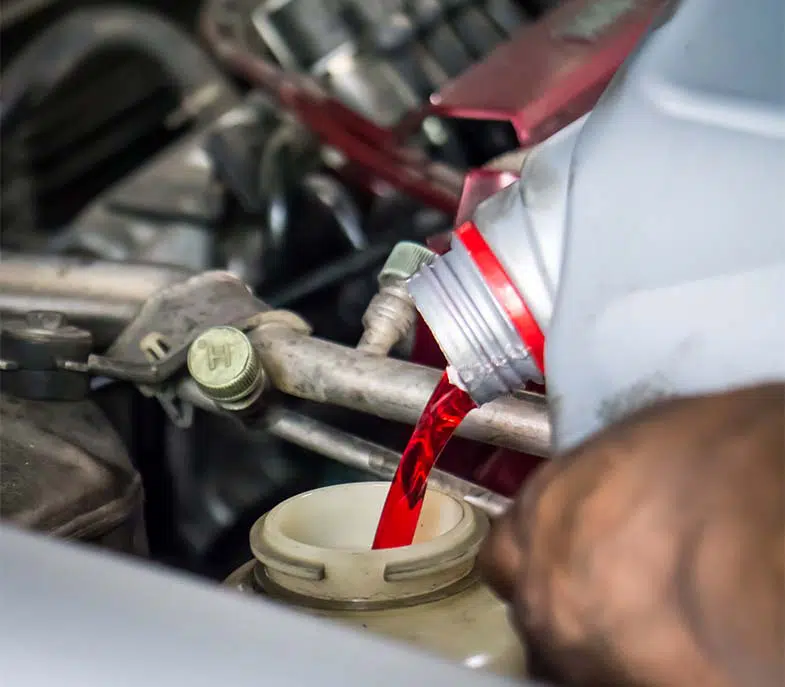No car owner can undermine the importance of the transmission fluid. This lubricant guarantees your wheeler’s smooth operation by targeting friction-producing components. Additionally, it conditions seals and gaskets, controls temperature, and makes metal surfaces wear-resistant. Given its vital role, it is crucial to know the right amount of transmission fluid your vehicle needs.
How much transmission fluid do I need? Depending on the make of your car and several other factors, vehicles take an average of 4 to 17 US quarts (3.8 to 16 liters) of transmission fluid to fill. It is best to refer to the car’s service manual for the specific amount of transmission fluid it needs.
In addition to quantity, this article will discuss variances in fluid requirements, different types of automatic transmission fluids, and other facets that impact a vehicle’s fluid consumption and change frequency. Read on to learn more – These bits of information will be worth your while.

Benefits of Transmission Fluid
This lubricant is responsible for smooth shifting, wear-and-tear protection of transmission components, and increased RPMs and maneuverability of your vehicle.
With the many benefits the transmission fluid brings to the table, more and more owners are becoming adamant in ensuring there is always ample fluid in the transmission.
Inspecting Fluid Levels
Determining the need for a transmission fluid change is never guesswork. Inspecting fluid levels typically indicate when you would need to top up your vehicle. Some drivers, however, tend to neglect regular inspection, which consequently leads to encountering one of several known transmission issues, as follows:
- Burnt smell or humming/buzzing noise within the vehicle
- Power loss
- CEL or Transmission Temperature Light (TTL) coming on for no apparent reason
- Consistent jumping of gears or shifting delay
- Disengaged transmission while driving
- Grinding or other types of engine noise
- Intermittent surging
- Overheating
- Transmission slippage or engine revving high without shifting
- Visible fluid leak from the engine block
Encountering any gearing or transmission issues above should warrant immediate examination of your transmission fluid levels and quality. Vehicles with dipsticks allow more convenient checking of fluid levels. However, those owning cars without dipsticks need not worry, as fluid on vehicles with sealed transmissions can be inspected by raising them levelly and accessing underneath.
While checking, make sure there are no leaks, and the transmission fluid is pinkish, clear amber, or cherry red for ATFs (not deep red, brown, or milky).
How Much Transmission Fluid to Add If Low or Empty
If your inspection confirms inadequate fluid levels, prepare to top up your car by starting the engine and letting it run for approximately five (5) minutes or until warmed up to operating temperature. Afterward, recheck the fluid levels. If still lacking, slowly add a quarter to a half quart of transmission fluid at a time. Do this last step repeatedly until you read full on the dipstick.
Check the cold and hot marks – the fluid level should be in the middle of these two in a warm engine. Whether the transmission is half-empty or fully drained, it is always best to pour in the transmission fluid little by little.
The only difference should be in the total amount of fluid you will feed your vehicle. More importantly, avoid overfilling the transmission to prevent damaging effects (discussed later in this article).
Transmission Fluid Requirements per Vehicle Type
The required transmission fluid amount is specific to a given car’s make and model and will never be similar to another, even if they fall under the same vehicle type. Your service manual will always be the best resource for this piece of information. For your reference, here are the different vehicle types and their fluid requirements in the table below:
(Note that the following details are based on top brands for 2021 and do not constitute an exhaustive range of transmission fluid requirements per vehicle type. However, these would come in handy, especially if you are looking to get a vehicle that requires the least transmission fluid.)

How Much Transmission Fluid Do I Need?
| Vehicle Type/s | Volume (US Quarts) | Volume (Liters) |
|---|---|---|
| City Car, Family Car, Sedan | 1.8 – 10.3 US quarts | 1.7 – 9.7 L |
| Convertible, Roadster | 2 – 10.6 US quarts | 1.9 – 10 L |
| Coupe, Muscle Car | 4 – 13.5 US quarts | 3.8 – 12.8 L |
| Estate Car, Station Wagon, Touring | 1 – 9.5 US quarts | 0.9 – 9 L |
| Green/Eco Car, Electric Vehicle (EV) | 1.5 – 4 US quarts | 1.4 – 3.8 L |
| Hatchback, Liftback | 1.9 – 9.1 US quarts | 1.8 – 8.6 L |
| Limousine | 9.5 – 12 US quarts | 9 – 11.3 L |
| Microcar | 2.5 – 6.3 US quarts | 2.4 – 6 L |
| Minivan, Crossover Utility Vehicle (CUV) | 2 – 9.7 US quarts | 1.9 – 9.2 L |
| Pickup, Commercial Vehicle | 2.2 – 12 US quarts | 2 – 11.3 L |
| Sports Utility Vehicle (SUV), Subcompact Car | 3.5 – 17.1 US quarts | 3.3 – 16.2 L |
| Supercar, Exotic Car, Sports/Race Car, Grand Tourer (GT) | 1.7 – 11.9 US quarts | 1.6 – 11.3 L |
A number of these vehicle types overlap with each other. For instance, the styling of many subcompact cars nowadays takes after SUVs and CUVs. Similarly, sedans can categorize as compact, mid-size, and full-size – to name a few.
The size difference between cars has a close-to-negligible impact on transmission fluid requirements. However, the reverse is true if considering other factors. How much transmission fluid is needed depends on the type of transmission, gearbox version, number of cylinders for fuel intake, the presence of a limited-slip differential, and whether it takes gas/petrol or diesel.
For example, recent-year diesel-fed and automatic-transmission wheelers appear to need more transmission fluid than more remote cars. In much the same way, manual-transmission models require less transmission fluid than semi-automatic and automatic ones.
There’s also a big difference in how much transmission fluid to add, depending on whether you are doing a transmission flush versus a dry fill or service fill.
Transmission Flush vs. Pan Drop
Knowing the difference between these two can be confusing but fundamentally necessary in performing a transmission fluid change correctly. As its name suggests, a transmission flush purges (or flushes) your vehicle of transmission fluid.
A pan drop (a.k.a. fluid change) eradicates dirty fluid from the transmission pan, replacing it with fresh fluid that mixes with old but usable transmission fluid left in the car.
On average, it takes at least 10 US quarts (9.5 liters) of transmission fluid to flush dirty fluid from all relevant vehicle components thoroughly. More complex engines and transmission systems may require higher fluid quantities than smaller wheelers with simpler power mills. Furthermore, a transmission flush does not automatically resolve transmission issues.
It is crucial to thoroughly inspect the transmission fluid before doing any of these procedures. You are okay to proceed with either a flush or fluid change if the fluids are darker but still have a pinkish or clear amber tint.
However, blackish transmission fluids accompanied by residue, metal shavings, or a burnt smell are a no-go. The presence of contaminants and level of discoloration could indicate gearbox damage or other transmission issues, which require a professional mechanic’s expertise.
Dangers of Overfilling
Whichever means you top your car up with transmission fluid, there is one rule of thumb to follow – never overfill. It may seem counter-intuitive, but here are several reasons veteran vehicle owners discourage overfilling:
- Difficulty in shifting (a symptom of a foamy transmission fluid)
- Inadequate lubrication within the crankshaft resulting in overheating engine
- Oil starvation
- Part pitting, failure, or damage due to excess pressure caused by excessive fluid amounts
- Seal failure leading to a transmission rebuild
- Transmission fluid leaks – telltale signs include puddles or drips underneath the transmission
- Vehicle malfunction
Considering these consequences, you will be better off strictly adhering to the manufacturer-recommended transmission fluid quantities. Following what is in the service manual will prevent the occurrence of the above problems and ensure the seamless operation of your vehicle.

How Often Do You Need to Change Transmission Fluid?
Most manufacturers recommend performing fluid flushes every 30,000-60,000 miles for a manual/CVT, 60,000-100,000 miles for an automatic, and checking fluid levels at least twice a year for each. However, when to change your transmission fluid ultimately depends on your specific vehicle. Furthermore, vehicles driven in severe driving climates may require more frequent fluid change and inspection.
What Transmission Fluid Do I Need? (The Different Types)
ATF+3, ATF+4
This is a synthetic fluid for finely-tuned transmissions, such as those found in Chrysler vehicles produced by FCA (now Stellantis). As such, this transmission fluid is formulated specifically for Chrysler-brand vehicles – like how Dexron and Mercon fluids are for GM and Ford cars and trucks.
Dexron II/III & Mercon
Many imported vehicles require this particular transmission fluid. It is a type of ATF or Automatic Transmission Fluid commonly used in GM and Ford units. Other popular brands that use this transmission fluid are Chevy, Buick, Cadillac, and Oldsmobile cars and trucks. Note this is different from Mercon V. Additionally, most of its newer versions are backward-compatible.
Highly Friction Modified Fluids
Otherwise referred to as HFM-style transmission fluids, they offer different friction characteristics from Dexron III/Mercon. Also, they are not as exclusive to specific vehicles, unlike other transmission fluids in this list. Other names of HFM fluids include Chrysler’s ATF+ and 7670.
SP ATFs
Other Japanese manufacturers like Hyundai and Mitsubishi used this in their wheelers. However, it is not multi-vehicle compatible and would not work on Subaru and Nissan cars and trucks, which use ATF-HP transmission fluid and Dexron II/III.
Type F
This transmission fluid was one of the first two fluid types available in the market. Type F was for Ford vehicles that used bronze clutches, the last of which was the ’70s Cruize Matic. Although still available, this fluid is only suitable for pre-1977 wheelers and other classics or vintage cars.
Z-1 & DW-1 ATFs
These fluids work best with Honda vehicles. DW-1, in particular, is a synthetic upgrade of the Z-1 and backward-compatible with the latter fluid type.
Conclusion – How Much Transmission Fluid Do I Need for My Car?
On average, passenger vehicles take between 4 and 17 US quarts (3.8 to 16 liters) of transmission fluid to fill. Green cars and manual-transmission automobiles require the least transmission fluid, while pickup trucks and luxury cars need the most. Regardless of vehicle type, avoid overfilling the transmission.
Like all other cars, regular inspection of the transmission fluid and overall upkeep of the vehicle is always the best approach. Religiously keeping to scheduled, periodic maintenance keeps a ton of issues at bay. If your daily commuter is not subject to hard-driving, then a high-quality lubricant and timed fluid changes should keep your vehicle running in tip-top shape for a very long time. Otherwise, you can always reach out to a professional mechanic for servicing and technical assistance.
Kris is an avid off-roader and outdoor enthusiast who loves to brave the elements and take on challenging terrain. He also enjoys sharing his passion and knowledge with others so that they, too, can appreciate the ride.
About Kris
